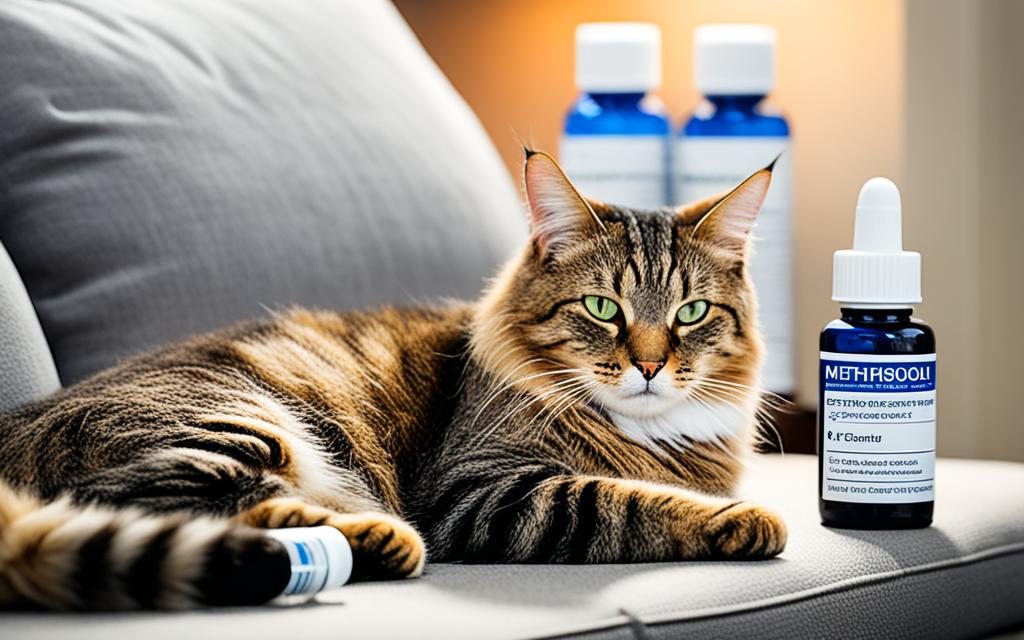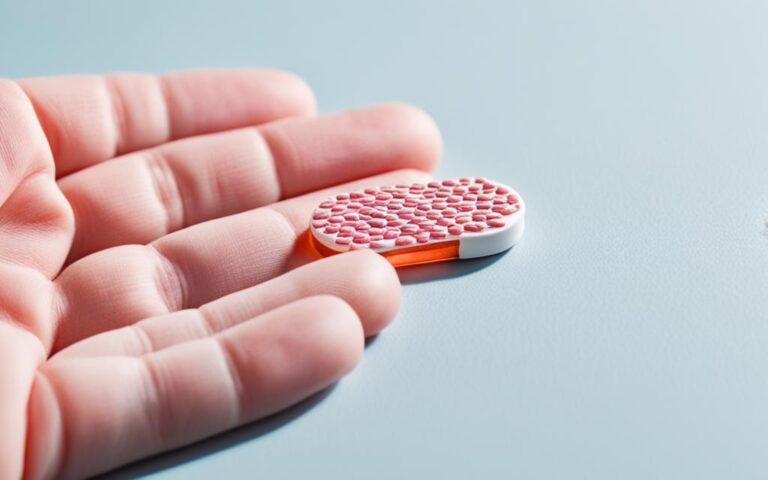Methylprednisolone (Medrol®) for cats: Uses and dosage chart
Did you know that methylprednisolone is a key medicine for cats? It’s an FDA-approved drug that fights inflammation and acts as a steroid. This medicine is a big help for cats with health issues. For example, it’s crucial in saving the lives of cats with very low cortisol, a sickness called Addison’s disease1.
methylprednisolone is also great at calming down the immune system in cats1.
Key Takeaways
- Methylprednisolone (Medrol®) is an FDA-approved prescription medication for cats and dogs.
- It can be used to treat a variety of medical conditions, including Addison’s disease and inflammatory disorders.
- Proper dosage and duration of treatment are essential to avoid potential side effects.
- Methylprednisolone may weaken the immune system, making pets more susceptible to infections.
- Long-term use of higher doses can lead to severe side effects like weight gain, vomiting, and gastrointestinal ulcers.
Table of Contents
What is Methylprednisolone (Medrol®)?
Methylprednisolone is a man-made medicine widely used by vets2. It’s part of the corticosteroid drug group. This medicine helps control different blood cells and how our immune system works2. Its main job is to fight swelling and reactions our body has against attacking itself. But, unlike similar drugs, it doesn’t make the body keep extra salt and water as much2.
Understanding Drug Mode of Action
This drug really works well at stopping swelling early. It deals with problems like fluids building up, cells clumping together, and tiny blood vessels widening. It also stops the later parts of swelling, such as new blood vessels growing and thick scar tissues forming2. By hitting at swelling in many ways, it’s great for many illnesses and allergic responses in cats.
Benefits of Methylprednisolone for Cats
Cats can use this drug for many issues. Some examples include skin problems, allergies, eye or ear infections, and joint pain. It can even help with adrenal issues and how the body handles sugars and water when the adrenal gland is not working well2.
For vets, this drug is very important. It helps lower swelling and stops the body’s reaction against itself. This can make a big difference for cats with various health problems2.
Indications for Methylprednisolone (Medrol®) in Cats
Methylprednisolone, found in Medrol®, is a widely used corticosteroid for cats. It helps with many issues3. This medicine is good for treating skin problems, allergies, eye issues, ear problems, and sore muscles. These often need the power of a corticosteroid to get better3.
For skin problems like eczema or hives, Medrol® works well3. It also helps cats with allergies, asthma, and eye or ear inflammation3.
Its anti-inflammatory and immune system calming effects make it perfect for muscle and joint issues too, like arthritis3. It can also handle long-term mysterious diseases such as colitis. These conditions often respond well to this drug3.
All cats that might need Medrol® should be checked by a vet first. The vet will decide the right dose for each cat and how long to use it. They will also watch for any side effects and make any needed changes to the treatment3.
“Methylprednisolone has been a game-changer in managing my 12-year-old Westie’s allergies and other medical issues. The improvement in her condition has been truly remarkable.”
Contraindications and Precautions
Methylprednisolone is a strong anti-inflammatory steroid. It’s more potent than prednisolone. Yet, it doesn’t make the body hold onto sodium and water as much4. But, we must think carefully before using it. In some cases, it shouldn’t be used at all or needs special care.
Conditions to Avoid Methylprednisolone Use
Methylprednisolone and prednisolone shouldn’t be given if an animal has particular health issues. For example, they are not suitable for animals with certain infections, stomach ulcers, severe mental issues, or a specific hormone problem4. Using these drugs in animals with diabetes, weak bones, severe mental problems, and other issues needs close monitoring4. These problems might not often happen in cats, but we should still be careful.
Considerations for Pregnant or Lactating Cats
If corticosteroids are given to pregnant animals late in pregnancy, it can cause early birth. This may lead to serious birthing complications and even death of the babies. Birth defects like cleft palate or missing limbs can also happen if pregnant animals get these drugs5. That’s why using methylprednisolone in pregnant cats or those nursing their kittens needs to be very thought out.
“Corticosteroids administered to pregnant animals have resulted in congenital anomalies, including cleft palate, deformed forelegs, phocomelia, and anasarca.”

So, using methylprednisolone needs careful thought. It’s best to avoid it in some cases or be very cautious in others. Veterinarians must weigh the risks and benefits closely. This is key to keeping cats safe and healthy465.
Administering Methylprednisolone (Medrol®) to Cats
Dosage Chart and Frequency
The right dose of Methylprednisolone for a cat depends on its weight. For cats 5-15 pounds, use 2 mg. If a cat is 15-40 pounds, they might need 2 to 4 mg. Larger cats, from 40 to 80 pounds, can have 4 to 8 mg7.
This medicine should be split into several doses given throughout the day, every 6 to 10 hours.
It’s best to give Methylprednisolone with food to prevent tummy issues. Make sure your cat can drink plenty of water, too7. For injections, the Depo-Medrol suspension is available in different strengths and bottle sizes. The usual injected dose is between 10 and 20 mg, every 4 to 6 weeks for long-term conditions7.
Directions for Use and Missed Dose Guidelines
If you miss a dose, check with your vet to see if you should give it now or wait till the next one. It’s unwise to suddenly stop this medication, as it can have bad effects. Always lower the dose gradually with the help of your vet7.
Cats may need more steroid medicine than dogs but often show fewer side effects if used for a short time7. Keep an eye on any bad reactions when they take this medicine with others. Also, watch out for any need to change the insulin dose in diabetic cats7. If you see any bad signs, call your vet or these poison control centers right away7.
Potential Side Effects of Methylprednisolone (Medrol®)
Methylprednisolone is often prescribed for health issues in our feline friends. But it comes with some side effects, especially with long or strong treatment1. These can include things like drinking more, going to the bathroom more, and wanting to eat more. They might also gain weight, breathe heavily, throw up, have loose stools, get gut ulcers, and lots more. Use with care if your cat has diabetes, as it might need more insulin1. Too much steroid use over time could even lead to Cushing’s syndrome, which isn’t good news1.
When compared to another similar drug called prednisolone, methylprednisolone is safer in general8. Pets seem to handle it better, showing fewer bad reactions, especially in terms of their stomach and gut8. But if your pet has diabetes, please note that their insulin needs could go up8.
Cats with certain health conditions, like diabetes and kidney issues, need extra caution when using methylprednisolone1. Giving too much can result in bad stomach problems1.
For things like asthma in cats, using steroids you breathe in is safer than eating them. The idea is to use the smallest helpful dose for a brief time to cut down on risks9.

In the end, methylprednisolone can do a lot of good for our furry pals. But always watch for side effects and be careful, especially with sick cats. Talk to your vet for the best advice on using this drug right198.
Methylprednisolone (Medrol®) for cats: Uses and dosage chart
Methylprednisolone, known as Medrol®, is a strong corticosteroid for cats10. It helps with many medical issues by reducing inflammation and weakening the immune system10. It’s much stronger than hydrocortisone and slightly more effective than prednisolone10.
It’s mainly used for feline asthma, inflammation, and flea allergy problems10. The dose for asthma is 1-2 mg for every kg of the cat’s weight. This is given in a depot injection every 1-3 weeks10. For inflammation or flea allergies, cats can get a 5 mg injection for every kg every 2 months. Or they might take 1 mg by mouth for every kg each day. This daily oral dose can be lowered to 2-5 mg for each cat every 48 hours10.
| Condition | Dosage | Frequency |
|---|---|---|
| Feline Asthma | 1-2 mg/kg | Every 1-3 weeks (Depot Injection) |
| Inflammation or Flea Allergy | 5 mg/kg (Injection) or 1 mg/kg (Oral) | Every 2 months (Injection) or Every 24 hours (Oral), can be reduced to every 48 hours |
Methylprednisolone is powerful but can cause side effects10. Using it long-term can affect the adrenal glands and cause weight loss. It may also create issues like thinning skin, too much cortisol, vomiting, and diarrhea10. It could even slow down how fast wounds heal or infections clear up10.
Using this drug isn’t a good idea for pregnant cats or those with kidney problems or diabetes10. Combining it with NSAIDs raises the risk of stomach ulcers. And if a cat is getting drugs that reduce potassium, like amphotericin B or certain diuretics, low potassium in the blood may occur10. Insulin doses might need to go up if a cat is on both diabetes medication and methylprednisolone10. The drug’s effect might change with the use of other medications as well10.
Before starting a cat on methylprednisolone, vets must weigh the risks and benefits. They need to pick the right dose and way to use it based on the cat’s health and needs.
In short, Medrol® (methylprednisolone) is crucial for treating issues like asthma and allergies in cats. It works well but can bring side effects. Vets must be careful and make informed choices when using this medication.
Drug Comparison: Efficacy, Cost, and Side Effects
Veterinarians look closely at how well, how much it costs, and the side effects of different medicines. This is true for corticosteroid drugs like prednisolone and methylprednisolone (Medrol®)9. Even though these drugs are similar in fighting inflammation, they have key differences. These differences help in choosing the right one for a cat.
Comparing Methylprednisolone to Similar Drugs
Methylprednisolone and prednisolone are both synthetic drugs that help with inflammation in cats11. Methylprednisolone is more powerful in fighting inflammation and may have less effect on the cat’s sodium and water levels7. This might mean a lower dose could work well, reducing side effects.
The decision between methylprednisolone and prednisolone also considers cost and how easy it is to get them11. The vet will check the cat’s condition and choose the best drug based on these factors. They’ll also think about the risks and benefits of each medicine.
| Medication | Efficacy | Cost | Side Effects |
|---|---|---|---|
| Methylprednisolone (Medrol®) | More powerful against inflammation than prednisolone7 | Changes based on where you are and if it’s available | Side effects are similar to prednisolone, including more thirst, going to the bathroom more often, wanting to eat more, and stomach problems7 |
| Prednisolone | Works well for inflammation and immune issues11 | Changes based on where you are and if it’s available | Short-term: Less energy, raised chance of getting sick, more thirsty and hungry, gaining weight, throwing up, diarrhea, heavy breathing, peeing more9 Long-term: Feeling tired all the time, acting out more (aggression), immune system not as strong, more infections, slower healing for wounds, ulcers in the stomach, diabetes, getting too heavy, Cushing’s disease, leaking urine, losing hair, higher blood pressure, allergies, changes to skin or fur9 |
Choosing the right corticosteroid for a cat depends on the cat’s needs and the condition’s seriousness, along with the vet’s advice9. It’s key to keep talking with the vet and check on the cat’s progress. This is the best way to make sure the treatment is working well and is safe9711.
Storing and Handling Methylprednisolone (Medrol®)
It’s vital to store and handle methylprednisolone (Medrol®) properly for your cat’s wellbeing7. This medication is found in various strengths for cats, like 20mg/ml, 40mg/ml, or 80mg/ml. You can get it in bottles of 1ml, 5ml, or 10ml7.
Keep the tablets at room temperature, from 68°F to 77°F (20°C to 25°C), to keep them safe1. Make sure the container is tightly closed to keep out moisture and light1. Use the vial within 12 weeks of opening it7.
If you have a compound form of methylprednisolone, follow the storage tips from the pharmacy1. Always keep it away from kids and pets to prevent accidents1.
Following these storage steps will help keep methylprednisolone safe for your cat’s use1. It’s crucial to protect it from the wrong temperature, moisture, and light1.
| Concentration | Bottle Size |
|---|---|
| 20mg/ml | 5ml, 10ml |
| 40mg/ml | 1ml, 5ml, 10ml |
| 80mg/ml | 1ml, 5ml, 10ml |
“Proper storage and handling of methylprednisolone is crucial to ensure the medication’s efficacy and safety for your cat.”
Conclusion
Methylprednisolone (Medrol®) acts as a strong corticosteroid and anti-inflammatory drug. It’s widely used in vet care, especially for cats. It treats issues like dermal, allergic, ocular, otic, and musculoskeletal disorders12. Being an immunosuppressant13, it’s very helpful with proper use. A vet will set the right dosage and duration of treatment based on the cat’s needs.
Cats usually do well with this drug, but side effects are possible. Extra care is needed for cats with certain health problems, or during pregnancy and when nursing14. Cat owners must watch their pets closely and follow the vet’s advice when giving this drug.
In the right hands, methylprednisolone (Medrol®) can help a lot with cat health issues12. Cat owners should team up with their vet to use this prescription medication safely for their cats.
“Methylprednisolone is a powerful tool in the veterinary arsenal, but its use requires careful consideration and monitoring to ensure the best possible outcomes for our feline patients.”
Frequently Asked Questions
Owners are often eager to learn more about giving cats methylprednisolone (Medrol®). They have questions about safety, use, and how it compares to other drugs. Let’s dive into these commonly asked questions.
Is Methylprednisolone Safe for Cats?
Methylprednisolone is safe for cats when a veterinarian is closely watching. Discuss the cat’s current medications and medical conditions with the vet. This helps avoid health risks tied to hypersensitivity or certain medical issues15.
The vet decides if methylprednisolone is right for the cat, considering its symptoms and health conditions15.
Is Medrol® the Same as Methylprednisolone?
Medrol® is the same as methylprednisolone but known by its brand name. Its generic name is methylprednisolone16. They share the same active ingredient16.
How Does Methylprednisolone Compare to Prednisolone?
Methylprednisolone and prednisolone are similar glucocorticoid medications. Methylprednisolone is a bit stronger. It’s less likely to cause sodium and water retention than prednisolone17. These drugs have similar effects.
Vets may choose based on potency, cost, and what’s available. Cats usually need more prednisolone than dogs need prednisone. Prednisolone can lead to side effects like increased water intake, larger appetite, and digestive issues. But, cats usually handle these drugs better than dogs do15.
Vets look at each cat’s needs and health when picking the right drug and dose151617.
Additional Resources
For in-depth details on using Methylprednisolone (Medrol®) for cats, talk to your vet or check out these trusted resources:
The American Veterinary Medical Association (AVMA) has a lot of info on corticosteroids and Methylprednisolone for pets18. See more at www.avma.org/resources-tools/pet-owners/petcare/corticosteroids-pets.
The American Animal Hospital Association (AAHA) has tips on treating chronic illness in cats with Methylprednisolone19. You can learn from them at www.aaha.org/your-pet/pet-owner-education/ask-aaha/chronic-conditions-in-cats/.
VCA Animal Hospitals’ website also features facts and dosing info for Methylprednisolone in cats20. This content is at https://vcahospitals.com/know-your-pet/methylprednisolone-for-cats.
FAQ
Is Methylprednisolone (Medrol®) Safe for Cats?
Is Medrol® the Same as Methylprednisolone?
How Does Methylprednisolone Compare to Prednisolone?
Source Links
- Methylprednisolone (Medrol®) for Dogs and Cats
- Chronic Steroid Use – Mar Vista Animal Medical Center
- MethylPREDNISolone (Generic)
- Medrol for Animal Use – Drugs.com
- Steroid Treatment – Effects in Cats | VCA Animal Hospitals
- Methylprednisolone (Medrol®, Depo-Medrol®) for Dogs and Cats
- Depo-Medrol for Cats – Cats.com
- Medrol (Methylprednisolone) Tablet, 4 mg
- Side Effects Of Injectable and Oral Steroids In Cats
- Methylprednisolone Dose For Dogs & Cats | Vet Drugs List
- Immunosuppressant Therapy in Small Animal Medicine: What, When, and Why
- No title found
- Methylprednisolone – an overview | ScienceDirect Topics
- Congestive Heart Failure in Cats Linked to Corticosteroids?
- Prednisolone for Cats: Dosage, Safety & Side Effects – Cats.com
- Prednisolone & Piroxicam in Dogs & Cats with Cancer – The Pet Oncologist
- Uses, Dosage & Side Effects
- Methylprednisolone | VCA Animal Hospitals
- Steroid Use in Dogs and Cats
- Depo-Medrol l Methylprednisolone For Animals







